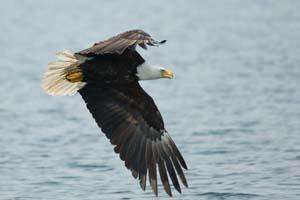
Fun Facts About Bald Eagles
Learn more about the Bald Eagle, a bird that continues to overcome adversity and fascinate nature lovers.
- Bald Eagles have faced many perils since the 20th century, mostly due to human interactions. Though they have been on the 'endangered species' list, moved to the 'threatened' list and have been recovering well with breeding pair introductions in many states, they still have a long way to go to reach their previously estimated population sizes.
- The Bald Eagle lives throughout a large part of North America, primarily in the US and Canada, and is usually found near rivers and bodies of water. This is the case in Edmonton, where Bald Eagles can be seen in Goldbar area and along the river valley.
- Bald Eagles are opportunistic feeders and usually prefer to eat fresh fish. During winter, they will eat more birds, mammals and carrion. Bald Eagles are attracted to the Goldbar area of Edmonton due to the concentration of ducks and other waterfowl in the warm open water from the water treatment plant. During the Edmonton Christmas Bird Count between as few as 2 and as many as 6 eagles have been counted in the past 7 count years, mostly along the North Saskatchewan River. One year a Bald Eagle was counted sitting on a tree south of Edmonton waiting for dinner as a pair of coyotes finished their meal of a deer that had apparently been killed by a car on the road.
- In summer, Bald Eagles have been seen at the Edmonton Grain Terminal on the Yellowhead Trail.
- Bald Eagles usually hunt from a high perch and glide down to catch their prey. They will strike from the air and are known to wade into shallow streams or rivers for fish.
- Bald Eagles are occasionally pulled into the water while trying to catch large fish. These birds are surprisingly good swimmers, using their wings to mimic a motion that is similar to the butterfly stroke.
- Bald Eagle nests are massive and can take months to build. They usually measure about 5 feet wide and 3 feet tall and are made of sticks and branches. The biggest recorded Bald Eagle nest was about 9 feet wide and 18 feet tall.
- Bald Eagles usually lay two eggs.
- Male Bald Eagles help the females incubate the eggs, and both care for the young after they hatch.
- Both parents are very careful around the eggs while in the nest. They will even clench their toes to possibly prevent the eggs from being punctured by their talons.
- Babies hatch in about 35 to 46 days and will leave the nest in 10 to 11 weeks. However, they will still be fed for a month after fledging.
- Juvenile Bald Eagles gradually spend time on their own away from their parents and learn to hunt by trial and error. They may eat a lot of carrion, especially fish, till they master hunting live food.
- Immature Bald Eagles have been known to explore vast areas for multiple years. Some Floridian young have been seen in Michigan, and some Californian young have gone as far north as Alaska.

